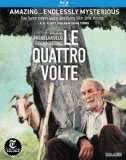| Reviews & Columns |
|
Reviews DVD TV on DVD Blu-ray 4K UHD International DVDs In Theaters Reviews by Studio Video Games Features Collector Series DVDs Easter Egg Database Interviews DVD Talk Radio Feature Articles Columns Anime Talk DVD Savant Horror DVDs The M.O.D. Squad Art House HD Talk Silent DVD
|
DVD Talk Forum |
|
|
| Resources |
|
DVD Price Search Customer Service #'s RCE Info Links |
|
Columns
|
|
|
Le Quattro Volte
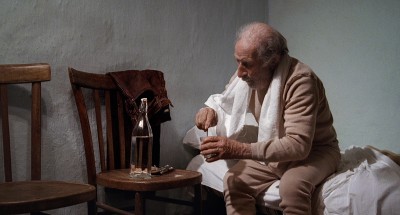
"Never, oh! never, nothing will die/The stream flows/The wind blows/The cloud fleets/The heart beats/Nothing will die." - Alfred, Lord Tennyson, "Nothing Will Die" (as quoted by Merrick's mother in David Lynch's The Elephant Man)
How on earth to describe a film as brilliant, sublime, and unusual as Michelangelo Frammartino's Le Quattro Volte? "Kind of like Bresson's Au Hasard Bathazar, except with a goat"--the first little phrase that floated into my awed, reeling head while viewing it--is not only way too incongruous and glib for such toweringly serious works, but also not entirely accurate, as the goat's story makes up only one portion of the film. It might be more à propos to say that it is a movie concerned with depicting the "circle of life," but minus any mysticism or applied grandeur. In that sense, it has the same subject matter--the stuff of life, no more or less--as Terence Malick's The Tree of Life, but it is the physical to that film's metaphysical, the yang to its yin.
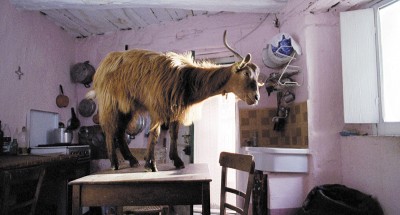
Le Quattro Volte's particular microcosm of the universal cycle of life takes place over the course of about a year (the changing seasons play a significant role) in and around a little, ancient, isolated Italian mountain village. True to its title, which translates as "The Four Times," the film is comprised of four sections that seem fairly discrete until we realize that one of the main points is their interconnectedness and interdependence. In the first, a poor, ageing goatherd (Giuseppe Fuda), who suffers from a chronic, cough-inducing respiratory illness, nurtures and tends his flock, and goes about his other routines of sweeping out the local cathedral, collecting and selling snails door to door (presumably, snails are used in the regional cuisine), and taking the folk remedy, apparently made from ashes, prepared for him by a woman who also works at the church. In the background, the town's other inhabitants prepare for an Easter pageant/Passion play, which takes place the same day that the old man slips gently out of this life.
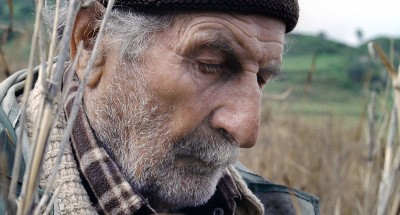
The second section then opens abruptly upon one of the departed old man's goats giving birth. We follow along with the experiences of the newborn kid as it grows, matures, and becomes part of the herd, up to the moment it lags behind and loses the rest of the goats and their new keeper and wanders, lost and bleating pitifully, coming to a (final?) resting place nestled under a tall tree. It is this tree, destined to be cut down and used by the villagers for an elaborate annual folk ritual that ends with its being felled and discarded, whose journey we see play out in the film's third section. Finally, the quasi-alchemical transformation--through an elaborate process meticulously detailed by Frammartino's camera--of the tree's lumber into charcoal/fuel for the town's use comprises the film's closing section. The last form of life we see as we fade down to the credits is the smoke produced by the burning of this coal as it escapes the chimneys and wafts away over the town's rooftops and off into the sky.
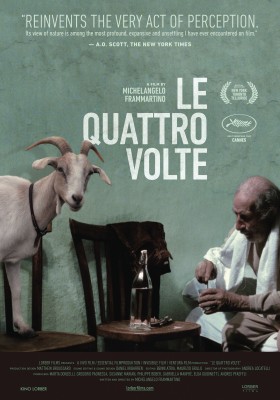
Whether one is inclined to see this progression from the most complex matter (human) to the very basic (coal, smoke) as a chain implying actual reincarnation or as a more direct, physical linkage of one element feeding into another (goatherd feeds goat, dying and/or waste matter of goat nourishes tree, tree breaks down to fossil fuel that feeds/is consumed by fire)--and the film easily allows for either interpretation--the overarching point is existence-as-continuum; that all living things, be they goats or dead wood, share the same basic building blocks . The film's take on this radical-seeming but in some ways quite down-to-earth conception of ourselves and all matter as being in and of each other is one of serene acceptance. Frammartino, cinematographer Andrea Locatelli, and editors Benni Atria and Maurizio Grillo create and structure the film's images into a thrillingly taut placidity. There is virtually no conventional "drama" (i.e., conflict with a potential solution) in Le Quattro Volte, but there is plenty of suspense due to the film's total unpredictability, an unpredictability that turns to inevitability as the film's shape and the true, unannounced vastness of its scope unfolds before our eyes. Starting off with a very long view of Life and then extending that perspective as far as it will go, the film very calmly, even reassuringly reminds us of how much smaller (and also how much bigger) human existence, and all life, are than we are accustomed to thinking. Whether you take its keen, exquisitely sensitive, purely visual observations as having a supernatural meaning or a philosophical one, it is a transcendent experience.
THE BD:
Kino presents Le Quattro Volte in an anamorphic widescreen (1.85:1 aspect ratio) AVC/MPEG-4 transfer, mastered at 1080p, through which the film's surpassingly beautiful cinematography retains every subtle, superb nuance. Particularly noticeable are the intermittent scenes of cloud shadows passing over wide-open spaces, which is indicative of the disc's overall visual quality. All the richness of this carefully planned contrast of light and dark are left intact in a flawless image, with nary a compression artifact to be seen.
Sound:This disc's Dolby Digital TrueHD 5.1 soundtrack (with a 2.0 soundtrack option included), in "Italian" (with no English subtitles, as the film has literally no dialogue), is superb, perfectly re-creating the finely-tuned "quiet" ambience of the film's sound design. Not only does it sound like there is actually a goat bleating in your living room; you are also surrounded, in the backbround, by all the sounds of the entire forest in which that bleat occurs.
Extras:Only the film's (rather nicely done) theatrical trailer, a stills gallery, and several trailers for other Kino/Lorber releases.
FINAL THOUGHTS:Sobering in its assertion of the fleetingness of all physicality (including our perishable human bodies), sublimely heartening in its view of all existence as one continuum, a cycle in which nothing is ever really lost or finished, Le Quattro Volte is a piercing, stoical film that evokes the deepest contemplation and the most profound feeling. You can take its quiet, patient, stunning glimpses of human, animal, vegetable, and mineral existence(s) as either physical or metaphysical, biological or spiritual, and still have full access to its enrapturing, transcendent qualities. For believers and nonbelievers alike, this is cinema as an experience that practically demands to be called "religious," if only in the sense that it is bound to convert every viewer into an avid disciple of Michelangelo Frammartino, its ingenious, preternaturally gifted writer/director. Highly Recommended.
|
| Popular Reviews |
| Sponsored Links |
|
|
| Sponsored Links |
|
|
| Release List | Reviews | Shop | Newsletter | Forum | DVD Giveaways | Blu-Ray | Advertise |
|
Copyright 2024 DVDTalk.com All Rights Reserved. Legal Info, Privacy Policy, Terms of Use,
Manage Preferences,
Your Privacy Choices | |||||||









